Streamline Accounts Payable with Robotic Process Automation (RPA)

Accounts Payable automation is evolving from simple task automation to powerful P2P process automation solutions. Today’s businesses can access automation tools that handle data, manage workflows, and communicate with other systems to streamline invoice processing, provide greater data transparency, and turn AP into a strategic engine.
Every accounting department has routine-but-important manual tasks that must be done and done right. These repetitive tasks are time-consuming and prone to human error, making them good candidates for automation. The challenge is finding the right automation solution for your business.
In this article, we’ll discuss how Robotic Process Automation (RPA) can help streamline business processes. We’ll briefly overview RPA systems, discuss which AP processes you can automate with RPA, and compare RPA to other AP automation solutions.
What is Robotic Process Automation (RPA)?
Robotic Process Automation (RPA) technology lets users create and teach software robots (bots) that can learn and perform rules-based tasks. In a nutshell, RPA bots learn by watching users perform tasks and then do the tasks themselves. For example, users can teach bots to copy and paste content, log in to programs, connect to APIs, extract data from files, and send communications.
You can train RPA bots to execute repetitive business tasks with 100% precision. They interact with systems and software applications just like people do, and they can learn and adapt to any interface or workflow. Bots with intelligent automation capabilities like image processing, machine learning, natural language processing, and pattern recognition can automate many accounting processes.
How does RPA automate Accounts Payable?
I’m the CFO of an auto parts retailer with 40 stores. We’ve struggled to manage our manual accounts payable processes, particularly invoice processing and new vendor onboarding. We use a SAS ERP system but still process most of our invoices by hand.
During the pandemic, our AP department shifted to a hybrid working model. At first, we had some challenges processing invoices, but we adapted and made it work. Now that things have returned to normal, our team wants to stay with the hybrid model. However, with our business growing, their workload is becoming overwhelming.
I’m exploring AP automation solutions such as RPA (Robotic Process Automation) and integrated third-party AP automation software to streamline our accounts payable processes. I’d also like to redeploy my experienced AP employees to more strategic, higher-value roles.
Let’s discuss how RPA can help us optimize invoice processing to boost cash flow, achieve cost savings, and free up our team to focus on more strategic and valuable tasks.
RPA with cognitive automation
RPA for accounts payable streamlines P2P processes by automating core AP workflows and eliminating manual tasks. We are considering RPA solutions with intelligent document management and cognitive abilities that can handle complex tasks like invoice scanning and entry, invoice verification, and approval routing.
Because these tasks involve a lot of data capture from unstructured documents (such as paper invoices and receipts), we need a tool with the flexibility and power to extract, interpret, and manage this data with minimal human intervention.
We’re considering a built-for-AP RPA solution that includes cognitive automation features like optical character recognition (OCR) and machine learning to help the bot understand, process, and verify invoices and decide when to ask for human intervention. For example, many of our vendors send paper invoices, and no two vendors use the same invoice layout or format. We need the RPA bot to be able to interpret and enter these invoices without human intervention but know when to ask for help if it hits something it can’t process.
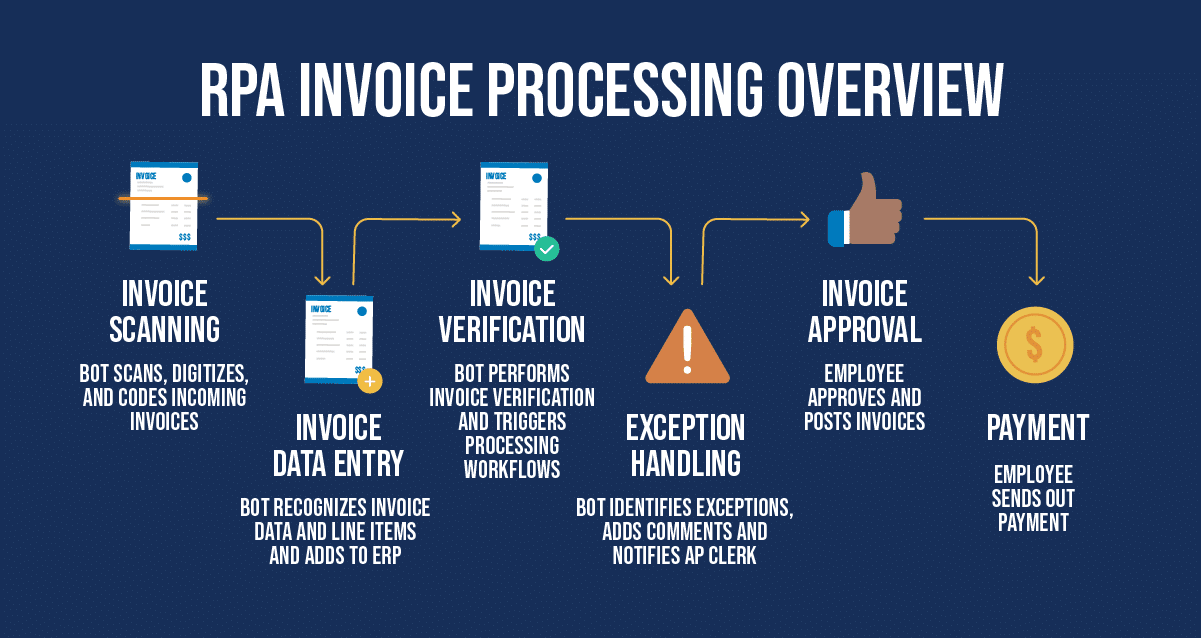
Here are the core functions we need the RPA solution to perform with minimal intervention:
- Identify emails containing invoices, purchase orders, and other AP documents
- Scanning, coding, and invoice data entry into the ERP
- Share AP data with our ERP (SAP), legacy systems, web browsers, and databases in real-time
- Perform account reconciliations
- 3-way match invoices with purchase orders and shipping receipts
- Onboard new vendors
Let’s break out these use cases and look at the benefits of RPA for accounts payable.
Invoice processing with RPA
Today, we get monthly invoices from over 4,000 vendors and add new ones all the time. That’s a minimum of 48,000 invoices per year, but the actual number is usually much higher since many of our stores manage suppliers directly. As I said, a big percentage of these invoices are on paper, although we’re working to move those suppliers to digital invoices.
By implementing RPA, we can streamline invoice processing by automating invoice entry, verification, and approval processes.
Invoice entry
RPA bots can locate an email containing a digital invoice, copy the invoice, scan and GL code the line items, and enter the invoice data into our ERP. Bots can also work with invoice scanning software to automate paper invoice scanning. We can also teach the bots to ask for human intervention if they encounter an invoice they can’t scan or if they’re unsure how to code a specific line item.
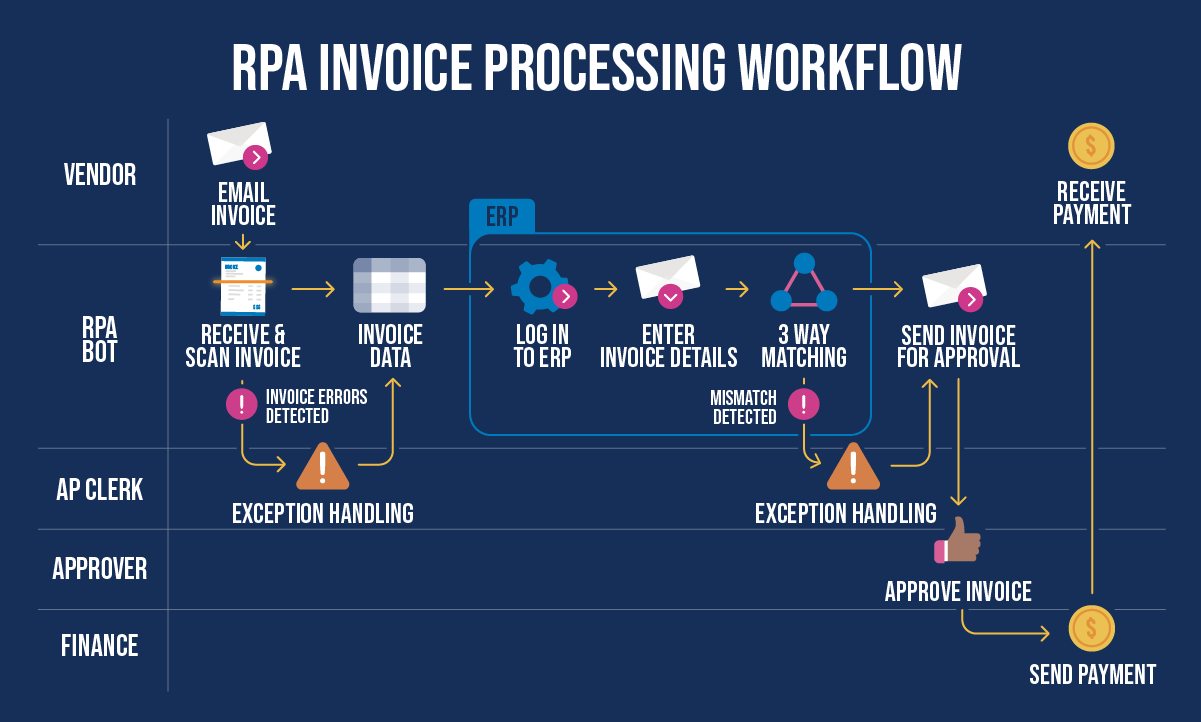
Invoice matching
Currently, we’re using manual two and three-way matching to verify invoices. Because the process is so slow, we only match high-value invoices. I’m concerned that we may be losing money to fraud and errors, but my AP team is already at capacity and can’t take on the extra work.
With RPA, a bot can verify every invoice. When it detects a deviation between an invoice, purchase order, or shipping receipt, the bot will flag the exception for investigation by our AP team. And because they won’t be overwhelmed by the invoice matching process, the team will be able to focus on solving the root causes of invoice deviations by working with vendors and internal stakeholders.
Approvals
Right now, we handle invoice approvals by email. Once the AP clerk enters and verifies an invoice in our ERP, they email the appropriate approver (or approvers). It’s a slow process, especially because emails are easily missed, lost, or forgotten.
We can automate this process with RPA by having the bot automatically forward the invoice after the invoice verification stage. If the invoice passes verification, the bot will email the invoice to the approver for sign-off. The bot will send a reminder email if the approver doesn’t respond within a certain time. Once the approver signs off on the invoice, they forward it to Finance for payment.
Note this is still a highly manual process, even with automation. We haven’t added an AP module to our ERP, so we still need to handle approvals by email. We’ve been considering adding an AP module as part of the streamlining process.
If we had a module in place, we could program an RPA bot to interact with the module to automate the approval and payment process. However, we have concerns about adding an AP module, as we’ll explain later.
Account reconciliations
RPA bots can also perform account reconciliations in real-time to ensure records are accurately matched. The bot can reconcile each day’s transactions by automatically downloading bank statements, logging into SAP to compare them to our records, and producing a report noting any unusual or missing transactions. This lets us maintain an up-to-date audit trail of transactions and journal entries.
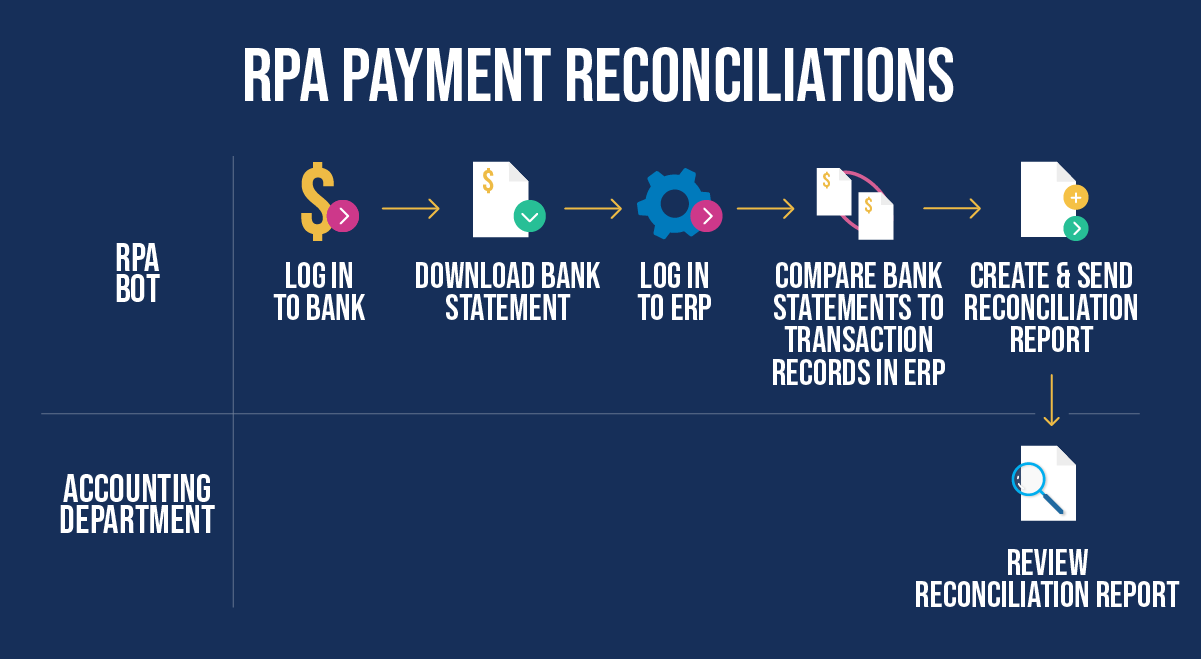
Adding new vendors
Right now, we use a manual process to onboard new vendors and set them up in our ERP. It’s time-consuming, and it ties up employees I’d rather have working on higher-value projects.
An RPA bot can automatically email a new vendor and ask them to complete a new vendor form. Once the vendor returns the form, the bot can check it to see if it’s complete, then automatically set up a new vendor in our ERP and add the vendor’s information. Once the vendor is set up, the bot notifies the vendor and our internal stakeholders to let them know everything is good to go.
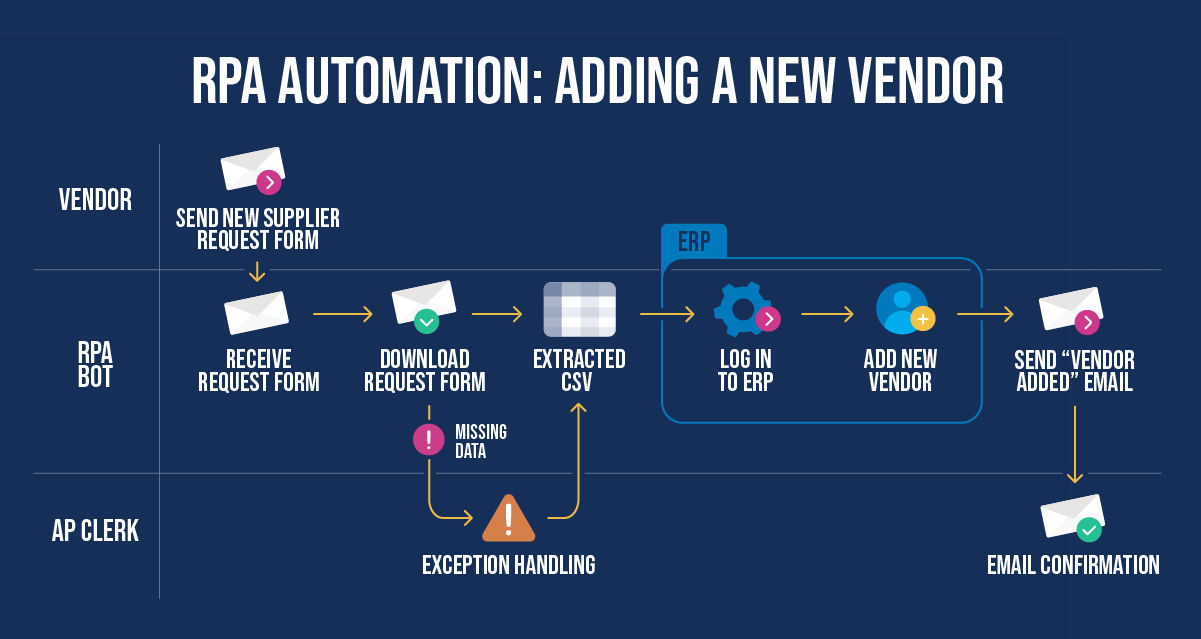
The “human in the loop” – attended vs. unattended RPA
One of my concerns with accounts payable automation is losing control over our mission-critical processes like invoice verification. We need a solution that allows our employees to intervene at key decision points to ensure the automation system is on-track.
RPA solutions come in two types: attended and unattended. It’s important to know the difference between them and which one to use where.
Attended RPA solutions require human intervention. They are manually triggered to execute a task and may require human decision-making at key points. We use attended RPA solutions for mission-critical processes like invoice entry and verification and supplier payments.
Unattended RPA solutions are triggered automatically to complete an end-to-end task or process and require no human intervention. These processes are fine for less critical processes such as report generation.
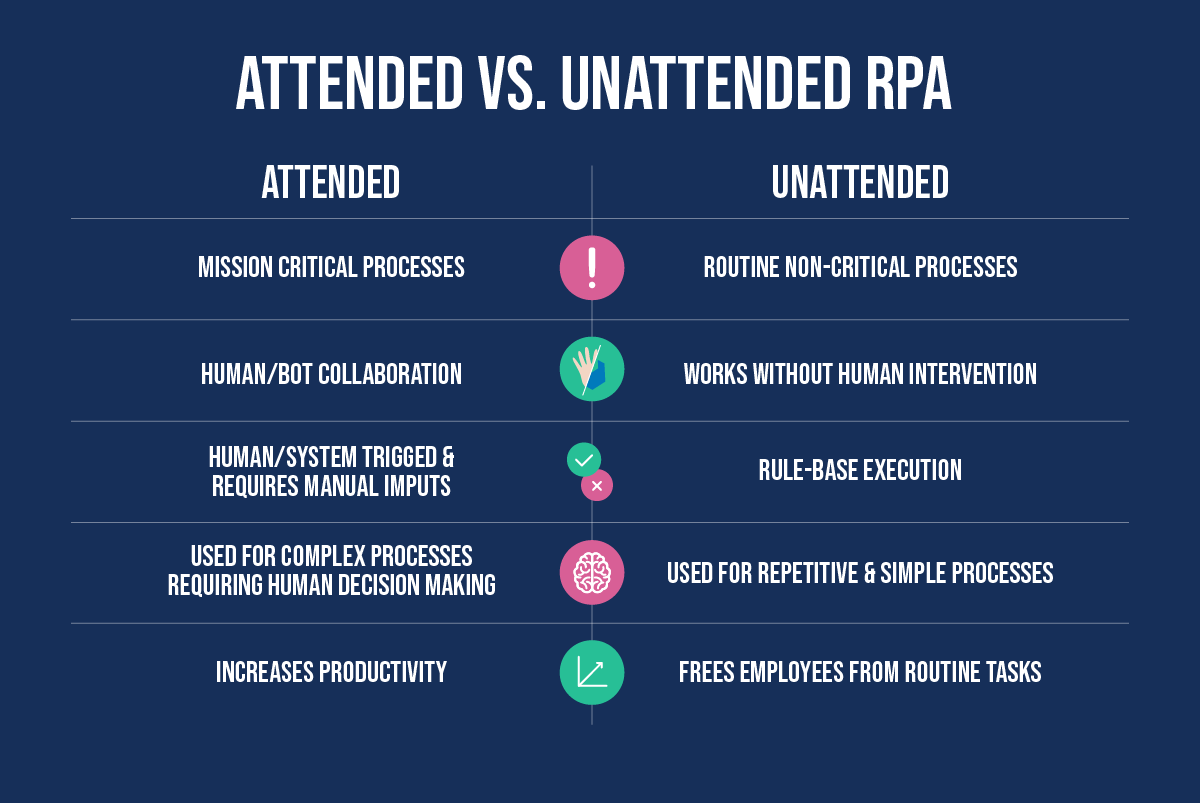
While RPA automation has significant advantages for automating accounts payable, it isn’t the best fit for our business. We prefer an end-to-end AP solution tailored to the unique needs of accounts payable teams.
Why made-for-AP automation is a better fit
Although we could see the potential in RPA automation for our accounts payable workflows, there are a few key areas where it falls short of our needs.
Here’s our rationale.
One end-to-end solution designed for accounts payable
End-to-end AP automation solutions are designed to automate every aspect of the procure-to-pay process, from purchase order processing to supplier payments. We like that the solutions have a single dashboard where our employees can monitor and manage all our AP processes without switching apps. End-to-end solutions are also designed for how AP teams work, so it’s easy for our employees to learn the platform and do their jobs.
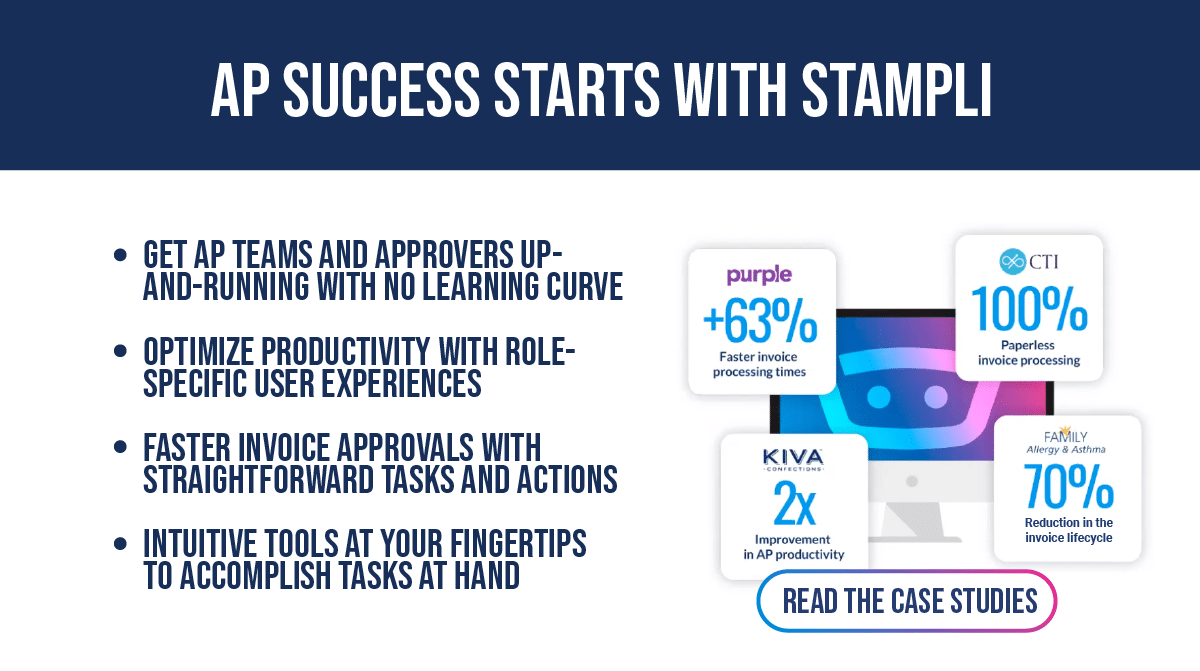
We also like that AP solutions are designed specifically for accounts payable processes. For example, several AP automation solutions offer AI-powered invoice processing with machine learning to simplify complex tasks like invoice coding and three-way matching. These solutions automatically learn our internal processes and have the flexibility to manage things like partial invoices and multiple POs.
Human in the loop
Although RPA solutions provide opportunities for human intervention in critical workflows, we wanted more flexibility and control over when our automation solution “checked in” with our team for validation. AP automation solutions are designed to include employees at key points in the process. Solutions like Stampli also feature centralized communications and vendor portals that allow employees to investigate and address discrepancies without leaving the AP dashboard.
Not tied to legacy systems
Because they work with our existing ERP and business systems, RPA solutions tend to tie us to these systems. For example, if we changed ERP providers, we’d need to build a new RPA solution to use with our new ERP system. Stand-alone AP automation solutions like Stampli work with most ERPs and business systems, giving us the flexibility to change our legacy systems whenever we want.
Integrates and shares data with ERP
Many AP automation solutions offer third-party integrations with ERPs, accounting software, and other business applications. They can share transaction data and communications via API or other connections so our entire organization is working from the same page. Integration provides us with access to real-time transaction data, which greatly benefits reporting and forecasting. It also makes it a lot easier for us to maintain a complete audit trail and effective internal controls to protect our business from fraud.
Stampli: the industry leader in end-to-end AP automation
Stampli is for Accounts Payable teams who want the evolutionary advantages of end-to-end AP automation but don’t want to change their processes or business systems. The only solution purpose-built for Accounts Payable, Stampli brings your AP workflows, documentation, and communications together in one place to turn AP into a strategic driver for your business.
It begins with Billy the Bot, Stampli’s industry-leading advanced AI.
Advanced invoice management with Billy the Bot
Billy the Bot goes beyond RPA to provide truly intelligent AP automation.
Billy uses artificial intelligence and machine learning to quickly learn the ins and outs of your invoice management processes and adapt to your unique business structure. He understands all line types, including GL, charges, fixed asset lines, and resources.
Billy can easily handle complex invoices, partial payments, and multiple POs, subsidiaries, locations, currencies, and tax structures. He makes invoice verification simple by checking every invoice for easily-missed errors and signs of fraud and notifying your AP team right away.
By effortlessly taking on time-consuming manual tasks like invoice capture, coding, approvals, fraud detection, and syncing data to your ERP, Billy gives you complete control and visibility over P2P workflows.
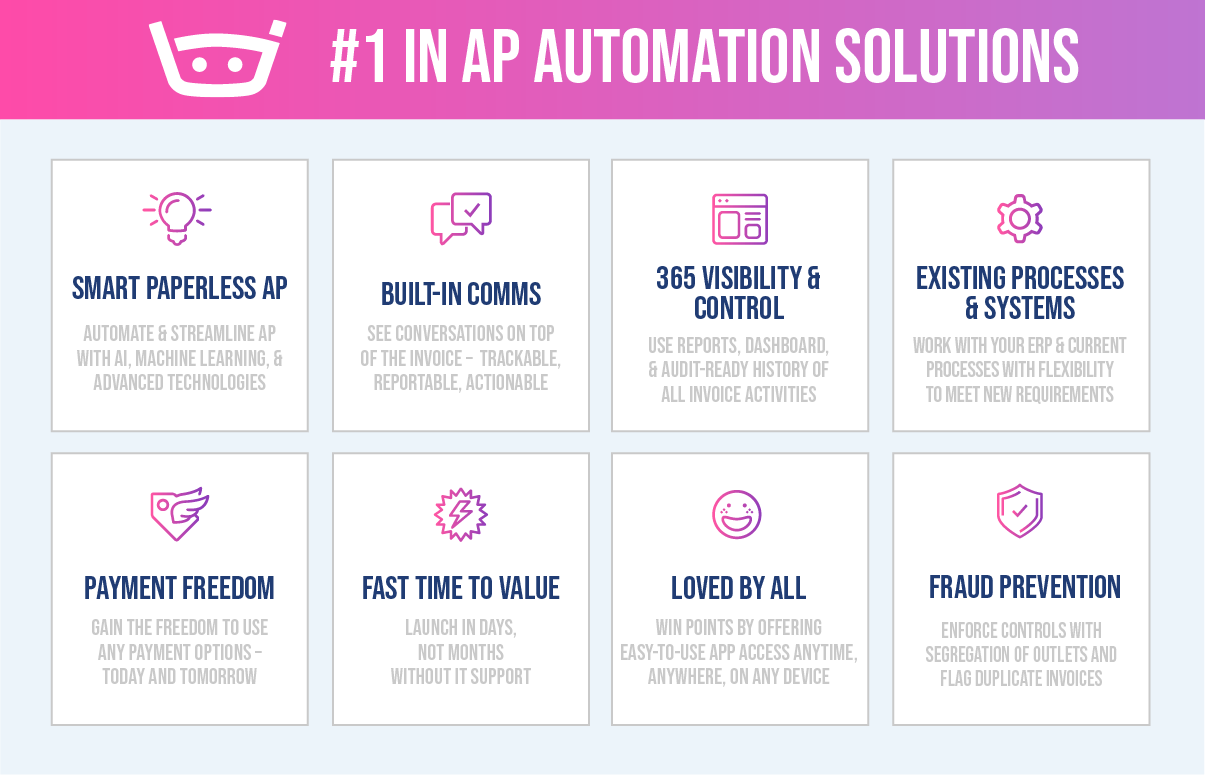
Seamless ERP integration
Unlike other accounts payable automation solutions, Stampli supports the full functionality of over 70 (and counting) ERPs and accounting systems, including Intacct, NetSuite, SAP S/4HANA, and Microsoft Dynamics. Stampli deploys and integrates within days with no disruption to your business or changes to your ERP or workflows.
The #1 accounts payable automation solution
Stampli is recognized as the leader in the G2 Grid for AP automation software and has been rated #1 by users for Customer Support, Implementation, and Delivering Results. We’ve been named a “Sage Tech Partner – Plus” by Sage Intacct – a recommended AP solution for Intacct customers. And we’ve been recognized several times as one of America’s best startup employers.
Stampli’s track record speaks for itself. Get real results by choosing Stampli as your AP automation partner today. Contact us to set up a free demo.
